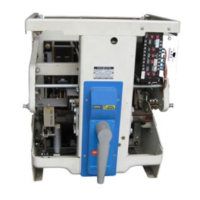GEK-7303
Low
Voltage Power Circuit
Breakers
For
the exact
characteristics
and setting of
each
breaker
in a selective system,
reference
should
l>e
made to the coordination
chart
furnished
for
the
particular
system.
BREAKER
ACCESSORIES
PRIMARY
DISCONNEOS
- AK-50 ·
ONLY
The
primary
discoruiects
are
attached to the
circuit
breaker
studs
at
the
rear
of the
breaker
base.
Each disconnect assembly consists of four
pairs
-of opposed contact
fingers.
The contact
fingers
are
secured to the
breaker
stud by two
bolts
which
pass
thrpugh the assembly and the
stud
of the enclosure; the disconnect
fingers
exert
a
set
amount of force against the stationary
stud
through the action of the compression
springs.
Retainers
and
spacers
hold the contact
fingers
in
correct
. alignment
for
engagemenf with the stud.
The amount
of
force which the fingers
exert
against
the stud
is
determined _by the degree to
-which the springs
are
compressed by the bolt and
nut
~hich
_hold the assembly
toge~~r.
·
REPLACEMENT
If
for
any
reason
. the disconnects must
be
replaced
.
or
_removed, the position of the nuts on
the bolts should be carefully noted and the number
of
turns
of the nuts shoula be counted,
so
that
in
reassembly
the original amount of compression -
can
be
restor~d
by replacing the nuts to
their
fo.
rmer
position on the bolts.
The
primary
disconnects should always
be
kept
lubricated
with G.
E.
Co. D50H47
grease.
SECONDARY
DISCONNECTS
· The
secondary
disconnects
·
for
all
breakers
serve
as
connections between
breaker
control
cir-
cuit
elements
and.
external
control
circuits.
They
are
are
used
only on
drawout
breakers
and .
are
--
mounted on a horizontal
cross-channel
at
the
top
rear
of the
breaker.
A
terminal
board
serves
the
same
·
purpose
on
stationary
mounted and
general
purpose
enclosure
.mounted
breakers.
These
secondary
disconnects allow
removal
of
the
breaker
without the
necessity
of having
to
detach
external
connections.
The
movable
part
of
the
secondary
disconnects
consists
of
an
insulating body which holds a
_ conducting
spring-loaded
plunger
to which a
flex-
ible
lead
is
attached.
As
the
breaker
moves
into
its
enclosure,
the
plunger
is
-depressed. by
sliding onto the
stationary
disconnects of the
enclosure.
REPLACEMENT
1.
Unfasten disconnect body
from
breaker
cross-channel.
2. Open
tabs
which hold
wires
on
inner
side.
3.
Pull
contact tip
loose
from
hollow tube.
4.
· Remove contact
tip
by
cutting
wire
at
its
base.

